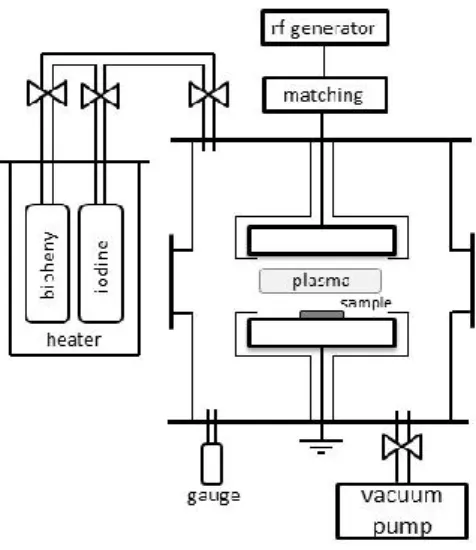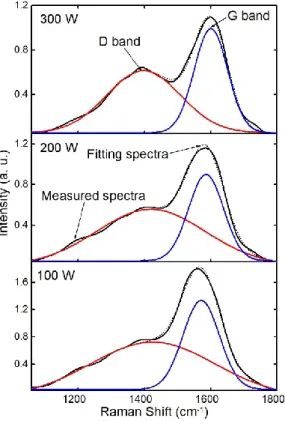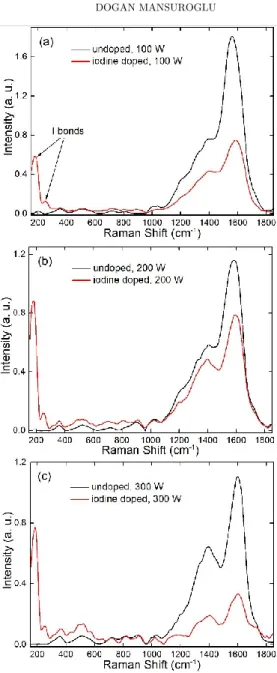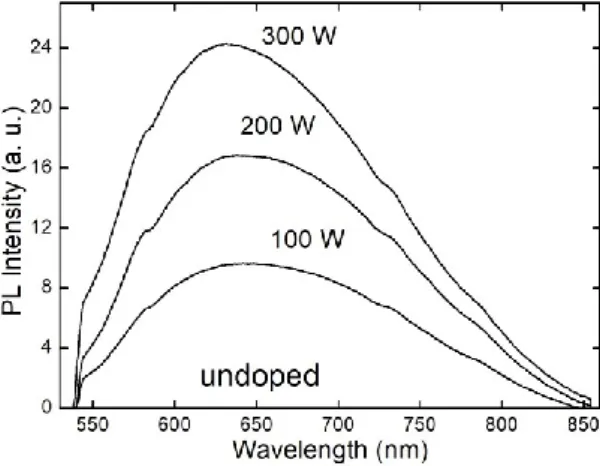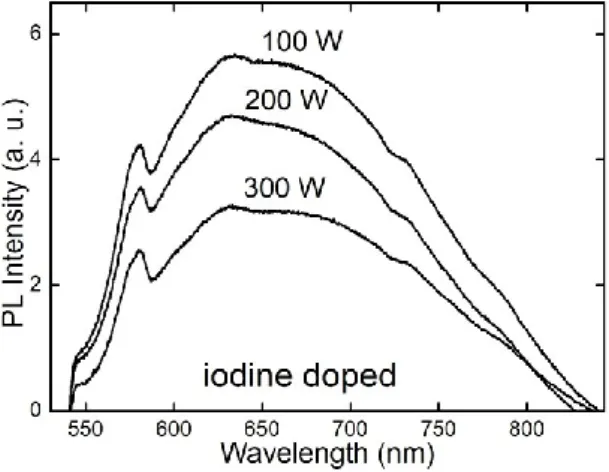Available online: October 30, 2018 Commun.Fac.Sci.Univ.Ank.Series A2-A3
Volume 60, Number 2, Pages 41-50 (2018) DOI: 10.1501/commua1-2_0000000114 ISSN 1303-6009 E-ISSN 2618-6462
http://communications.science.ankara.edu.tr/index.php?series=A2A3
Received by the editors: August 15, 2018; Accepted: October 30, 2018.
Key word and phrases: Plasma polymerization, iodine doping, Raman spectroscopy, photoluminescence.
© 2018 Ankara University Communications Faculty of Sciences University of Ankara Series A2-A3: Physical Sciences and Engineering
RAMAN SPECTROSCOPY AND PHOTOLUMINESCENCE CHARACTERIZATION OF THE IODINE DOPED
PLASMA-POLYMERIZED BIPHENYL THIN FILM
DOGAN MANSUROGLU
Abstract. The iodine doped plasma-polymerized biphenyl thin film is investigated in this study. Iodine atoms lead to increase the charge transfer complexes and change the electronic equilibrium in the polymer structure due to their high electronegativity. Therefore, the iodine doped films show significant improvements in the electrical characteristics as compared to the undoped ones. The results of Raman spectroscopy verify the presence of the iodined groups in the structure of deposited thin films. The number density of the iodined groups increases with increasing the radio frequency input power. The ID/IG ratio changes in a range from 0.40 to 0.72 for the undoped thin films while it decreases from 0.74 to 0.58 for the iodine doped thin films which can be due to the rearrangement in the structure. Photoluminescence spectra show a broad red emission band at about 630 nm as well as unclear bands placed like small shoulders at 580 nm and 731 nm. These bands become to seem clearly after the iodine doping process. The conjugation length of the polymer thin films increases with iodine doping as well as increasing the power values. All depositions are produced using a capacitively coupled plasma system with 13.56 MHz radio frequency source. During the doping process, the vaporized iodine material is directly exposed to the plasma discharge and mixed with the biphenyl polymer material. All results are characterized in detail.
1. Introduction
The plasma discharge is most commonly used to produce polymer thin films, namely plasma polymerization [1], [2]. It is a type of dry processing method and provides an opportunity to work at room temperature, no solvent requirements, and the ability to coat an arbitrarily shaped object [2], [3]. Different than conventional chemical deposition methods, pin-hole free polymer thin films are produced with high crosslinking and branching structures [1], [4]. Moreover, plasma polymerized thin films have higher quality and homogeneity and provide good adhesion due to increasing the degree of bondability as compared to conventional methods [1].
polymer materials due to their excellent electronic properties and good chemical stability [5]–[7]. These properties make them very favorable for several applications such as photovoltaics, light emitting diodes, optical coatings, and biomedical areas [4], [8]–[13]. Biphenyl (C12H10), a type of π-conjugated organic material, is an aromatic hydrocarbon including two benzene rings connected with a C-C bond. Due to its easy processing structure, the molecule of biphenyl is used as a source of the aromatic ring [3]. It can efficiently react with other molecular structures and provide an opportunity to form new compounds with easy control.
The doping process is a commonly used technique to increase the electronegativity of the polymer thin film and improve its electrical properties [9]. Iodine (I2), which has a high electronegativity, is one of the most used dopant materials [14]–[18]. It is a very compatible dopant material to act other materials. Iodine doping leads to change the electronic equilibrium of polymer molecule and increases the concentration of the charge transfer complexes in the structure. Therefore, iodine atoms perform as electron acceptors and improve the electrical conductivity of the polymer.
In this study, the plasma-polymerized biphenyl (C12H10) thin films are produced using a capacitively coupled radio frequency (RF) plasma system. The iodine dopant material is used to improve their electrical characteristics. The deposition and doping process of thin films are carried out at variable RF input power values (100 W, 200 W, and 300 W), the deposition time (20 min), and the pressure (0.2 Torr). The undoped and the iodine doped plasma-polymerized biphenyl thin films are investigated using the measurements of Raman spectroscopy and Photoluminescence. The results of the characterization are discussed in detail in Section 3.
2. Experimental Set Up
The experimental set up consists of a vacuum chamber including two parallel cylindrical electrodes, as shown in Figure 1. 13.56 MHz RF power supply is used, and the RF power is applied between the electrodes to generate the plasma discharge. Thin films are produced on glass samples. Biphenyl material is purchased from Sigma-Aldrich Company, ReagentPlus®, 99.5%. Solid biphenyl, melting at 69 °C, is evaporated into a reservoir by heating up to 130 °C. The volatile biphenyl is introduced into the vacuum chamber where the backfill pressure is about 10-3 Torr. As the biphenyl vapors fill the chamber, a pressure of 0.2 Torr, the RF power is activated. Iodine doping material is purchased from Sigma Aldrich Company, ACS reagent, ≥99.8%. During the doping process, the iodine is placed into a heating
RAMAN SPECTROSCOPY AND PHOTOLUMINESCENCE CHARACTERIZATION OF THE IODINE DOPED
PLASMA-POLYMERIZED BIPHENYL THIN FILM 43
reservoir at 200 °C and then introduced into the chamber directly by mixing with the biphenyl vapors.
Figure 1. Scheme of capacitively coupled RF plasma system
3. Characterization 3.1. Raman Spectroscopy
The chemical structures of the deposited thin films are investigated using Raman spectroscopy. The data are collected in a range from 150 cm-1 to 1850 cm-1 with a scan step of 2.2 cm-1. The Raman spectroscopy is performed using a Horiba-Jobin Yvon i550 system which includes a CCD camera and an Nd:YAG laser with a 532 nm wavelength.
The Raman spectra of the undoped thin films are shown in Figure 2 for 100 W, 200 W, and 300 W of RF input power. Peak intensities of the spectra show a decrease with increasing the power values. This is due to variable rearrangements occurring at different power values. During the plasma deposition, the first breaking is expected for the C-C bond between benzene rings of the biphenyl molecule. Then, H atoms dissociate from the benzene rings, and they fragment to smaller compounds. As a result, various fragments and compounds such as alkane, alkene and alkynes groups can be generated. These fragments react with other activated species. When unsaturated fragments/structures interact with each other, new saturated compounds
significantly dependent on the energy of the plasma discharge.
Figure 2. The D and G bands of the undoped thin films
The Gaussian fitting method is applied to the spectra, and the D and G bands are investigated. While the D band shifts from 1425 cm-1 to 1419 cm-1 and 1408 cm-1, the G band shifts from 1571 cm-1 to 1586 cm-1 and 1594 cm-1 with increasing the RF input power. The intensities ratio of the D and G bands (ID/IG) is calculated, and an
increase from 0.40 to 0.72 is obtained by increasing the power. According to Dwivedi et al. [19], the ID/IG ratio can be correlated with the sp3/sp2 ratio. Therefore,
it can be considered that the thin films generated at the higher power have relatively higher sp3 content. Moreover, the formation of π-type bonds is obtained with good quality due to the transfer of the high energy to the film structure.
The Raman spectra of the iodine doped thin films are shown in Figure 3. Iodine material has a high electronegativity and behaves more activated as exposed to the plasma discharge. The formed iodine radicals react with the fragments of the biphenyl molecules and generate new iodined compounds. The spectra show a
RAMAN SPECTROSCOPY AND PHOTOLUMINESCENCE CHARACTERIZATION OF THE IODINE DOPED
PLASMA-POLYMERIZED BIPHENYL THIN FILM 45
strong band at 179 cm-1 referring to the I
5- ion group [20]. A weak and broad band observed at 241 cm-1 corresponds to the existence of molecular iodine (I
20) [21], [22]. These seen bands verify the presence of the iodined groups in the structure of the deposited films. The iodine content increases with increasing the power. This shows the higher energy of the plasma discharge leads to more interactions and combinations with iodine atoms. In addition to the expected reactions, some side-reactions are also observed due to the iodine [14]. According to these side-side-reactions, hydrogen atoms removed from benzene rings connect with iodine atoms to generate HI molecules. These HI molecules react with CH groups. Then, fragments of the biphenyl molecule react with other iodine radicals, and this leads to form the mono-substitutions of aromatic structures.
As compared to the results of the undoped ones, the G band of the iodine doped films is achieved at higher wavenumbers, shifting from 1583 cm-1 to 1592 cm-1 and 1600 cm-1. The D band is obtained at lower wavenumbers, shifting from 1417 cm-1 to 1401 cm-1 and 1385 cm-1. This shifting in the wavenumber can be related to the rearrangement of the length of the π-delocalized structures [23]. The ID/IG ratio
decreases from 0.74 to 0.58.
Additionally, a broad band near 1160 cm-1, especially observed at 300 W, occurs due to the C-C stretching vibrations [22]. The spectra show the intensities of the D and G bands decrease after the iodine doping. It can be due to the structural modifications resulting from the interactions between the iodine and the biphenyl polymer lattice [22].
3.2. Photoluminescence
Photoluminescence (PL) spectra are acquired for the undoped and the iodine doped plasma-polymerized biphenyl thin films. PL spectra are collected using a Newport MS257TM monochromator equipped with Hamamatsu C7041 detector head. A 532 nm laser is used as an excitation source for room temperature. PL spectra of the undoped film show a broad band centered at around 630 nm of the wavelength which is assigned to red emission, as shown in Figure 4. The wavelength of the maximum PL peak exhibits small blue-shifting with increasing the RF input power, which may be due to the recombination of the donor-acceptor pair. The spectra also present two unclear bands giving small shoulders at 580 nm (green emission) and 731 nm (red emission). All locations of the band peaks are found by using a Gaussian decomposition process. This shows that the plasma-polymerized biphenyl thin films have different transitions of energy levels depending on the rearrangement of the structures.
Figure 3. The Raman spectra of the undoped and the iodine doped thin films for (a) 100 W, (b) 200 W, and (c) 300 W
RAMAN SPECTROSCOPY AND PHOTOLUMINESCENCE CHARACTERIZATION OF THE IODINE DOPED
PLASMA-POLYMERIZED BIPHENYL THIN FILM 47
Figure 4. PL spectra of the undoped thin films
Figure 4 shows that the intensity of the peaks increases with increasing the RF input power. As seen in Raman spectra, the plasma-polymerized biphenyl thin films have different chemical structures at various power values. Differences in structures lead to change the orientation of the film, which affects the optical characteristics of the polymer. As the number density of the oriented components in the structure increases, the transitions between the ground and the excited states become shorter. Thus emission with high intensity is obtained in the PL spectra [24]. The results show the higher number density of oriented components is observed at higher RF power values.
PL spectra of the iodine doped are shown in Figure 5. PL peak locations are found by using the Gaussian decomposition, and they place at around 580 nm and 630 nm. After the iodine doping, these peaks start to appear clearly. It can be considered that incorporation of the iodine carriers changes the transition process dependent on the levels of bonding. The intensities of the iodine doped spectra decrease as compared to the undoped ones. As iodine atoms react with the biphenyl molecules, they perform as electron-accepting components in the structures. Presence of the iodined groups leads to an increase in the number density of the charge transfer complexes and improves the electrical conductivity of the plasma-polymerized thin film. Additionally, iodine doping rises the conjugation length in the polymer and causes structural modifications. It can be concluded that changes in the structural formation and the increase in the conjugation cause the decrease observed in the intensities of PL peaks [25].
concentration of the iodined groups in the polymer structure. These groups presenting in the polymer structure utilize the electron transfer as a result of interacting with π-electrons of the aromatic rings. Thus, the charge transfer is provided from the lowest unoccupied molecular orbital (LUMO) level of the iodine doped groups to the conduction band of polymer [26].
Figure 5. PL spectra of the iodine doped thin films
4. Conclusion
The undoped and the iodine doped plasma-polymerized thin films are studied using a capacitively coupled RF plasma discharge. RF plasma discharge causes structural changes at different power values dependent on the rearrangement. These changes lead to a decrease in the intensities of Raman spectra as the RF power increases. Additionally, the ID/IG ratio changes from 0.40 to 072. The Raman spectra of the
iodine doped thin films prove the existence of the iodined components in the structure and their concentration increases at higher power values. Iodine atoms lead to more interactions occurring with the biphenyl compounds at the higher power values. The ID/IG ratio of the doped films decreases from 0.74 to 058. PL spectra
exhibit the deposited films have different transitions of energy levels in their structures. After the doping process, the PL intensities decrease with increasing the power values. This shows the extension is observed in the conjugation length of the structure.
References
[1] Yasuda, H., Plasma Polymerization. Orlando: Academic Press, 1985.
RAMAN SPECTROSCOPY AND PHOTOLUMINESCENCE CHARACTERIZATION OF THE IODINE DOPED
PLASMA-POLYMERIZED BIPHENYL THIN FILM 49
[3] Friedrich, J. “Mechanisms of plasma polymerization - reviewed from a chemical point of view”, Plasma Processes and Polymers, 8 (2011) 783–802.
[4] Shi, F.F. “Recent advances in polymer thin films prepared by plasma polymerization Synthesis, structural characterization, properties and applications”, Surface and
Coatings Technology, 82 (1996) 1–15.
[5] Friend, R.H., Gymer, R.W., Holmes, A.B., Burroughes, J.H., Marks, R.N., Taliani, C., Bradley, D.D.C., Dos Santos, D.A., Bredas, J.L., Lögdlund, M., Salaneck, W.R. “Electroluminescence in conjugated polymers”, Nature, 397 (1999) 121–128. [6] Shim, H., Jin, J. “Light-emitting characteristics of conjugated polymers”, Polymers for
Photonics Applications, 158 (2002) 193-243.
[7] Nelson, J. “Organic photovoltaic films”, Current Opinion in Solid State and Materials
Science, 6 (2002) 87–95.
[8] Martinu, L. Poitras, D. “Plasma deposition of optical films and coatings: A review”,
Journal of Vacuum Science & Technology A, 18 (2000) 2619.
[9] Denes, F.S., Manolache, S. “Macromolecular plasma-chemistry: an emerging field of polymer science”, Progress in Polymer Science, 29 (2004) 815–885.
[10] Biederman, H., Slavı́nská, D. “Plasma polymer films and their future prospects”,
Surface and Coatings Technology, 125 (2000) 371–376.
[11] Jacob, M.V., Easton, C.D., Woods, G.S., Berndt, C.C. “Fabrication of a novel organic polymer thin film”, Thin Solid Films, 516 (2008) 3884–3887.
[12] Hiratsuka, A., Karube, I. “Plasma polymerized films for sensor devices”,
Electroanalysis, 12 (2000) 695–702.
[13] Bernius, M., Inbasekaran, M., Woo, E., Wu, W., Wujkowski, L. “Light-emitting diodes based on fluorene polymers”, Thin Solid Films, 363 (2000) 55–57.
[14] Groenewoud, L.M.H., Engbers, G.H.M., White, R., Feijen, J. “On the iodine doping process of plasma polymerised thiophene layers”, Synthetic Metals, 125 (2002) 429– 440.
[15] Olayo, M.G., Morales, J., Cruz, G.J., Olayo, R., Ordoñez, E., Barocio, S.R. “On the influence of electron energy on iodine-doped polyaniline formation by plasma polymerization”, Journal of Polymer Science Part B: Polymer Physics, 39 (2001) 175– 183.
[16] Morales, J., Olayo, M.G., Cruz, G.J., Olayo, R. “Plasma polymerization of random polyaniline-polypyrrole-iodine copolymers”, Journal of Applied Polymer Science, 85 (2002) 263–270.
[17] Wang, J., Neoh, K.G., Kang, E.T. “Comparative study of chemically synthesized and plasma polymerized pyrrole and thiophene thin films”, Thin Solid Films, 446 (2004) 205–217.
[18] Paosawatyanyong, B., Tapaneeyakorn, K., Bhanthumnavin, W. “AC plasma polymerization of pyrrole”, Surface and Coatings Technology, 204 (2010) 3069–3072. [19] Dwivedi, N., Kumar, S., Malik, H.K., Govind, Rauthan, C.M.S, Panwar, O.S. “Correlation of sp3 and sp2 fraction of carbon with electrical, optical and
nano-mechanical properties of argon-diluted diamond-like carbon films”, Applied Surface
Science, 257 (2011) 6804–6810.
combination of X-ray diffraction, infrared/Raman spectroscopy and computer simulation techniques”, Polymer, 38 (1997) 2867–2879.
[21] Shestimerova, T.A., Yelavik, N.A., Mironov, A.V., Kuznetsov, A.N., Bykov, M.A., Grigorieva, A.V., Utochnikova, V.V., Lepnev, L.S., Shevelkov, A.V “From isolated anions to polymer structures through linking with I2: Synthesis, structure, and
properties of two complex bismuth(III) iodine iodides”, Inorganic Chemistry, 57 (2018) 4077–4087.
[22] Bin, Y., Chen, Q., Tashiro, K., Matsuo, M. “Electrical and mechanical properties of iodine-doped highly elongated ultrahigh molecular weight polyethylene films filled with multiwalled carbon nanotubes”, Physical Review B, 77 (2008) 035419.
[23] López Navarrete, J.T., Casado, J., Muguruma, H., Hotta, S., Hernández, V. “Vibrational spectra of charged defects in a series of α,α′-dimethyl end-capped oligothiophenes induced by chemical doping with iodine”, Journal of Molecular
Structure, 521 (2000) 239–247.
[24] Kim, M.C., Cho, S.H., Han, J.G., Hong, B.Y., Kim, Y.J., Yang, S.H., Boo, J.-H. “High-rate deposition of plasma polymerized thin films using PECVD method and characterization of their optical properties”, Surface and Coatings Technolology, 169– 170 (2003) 595–599.
[25] Saravanan, S., Mathai, C.J., Anantharaman, M.R., Venkatachalam, S., Avasthi, D.K., Singh, F. “Photoluminescence studies on RF plasma-polymerized thin films”, Synthetic
Metals, 155 (2005) 311–315.
[26] Lee, D.Y., Kim, E.K., Shin, C.Y., Shinde, D.V., Lee, W., Shrestha, N.K., Lee, J.K., Han, S.H. “Layer-by-layer deposition and photovoltaic property of Ru-based metal-organic frameworks”, RSC Advances, 4 (2014) 12037–12042.
Current Address: DOGAN MANSUROGLU: Department of Physics, Canakkale
Onsekiz Mart University, Canakkale TURKEY
E-mail: mansurdogan@gmail.com
